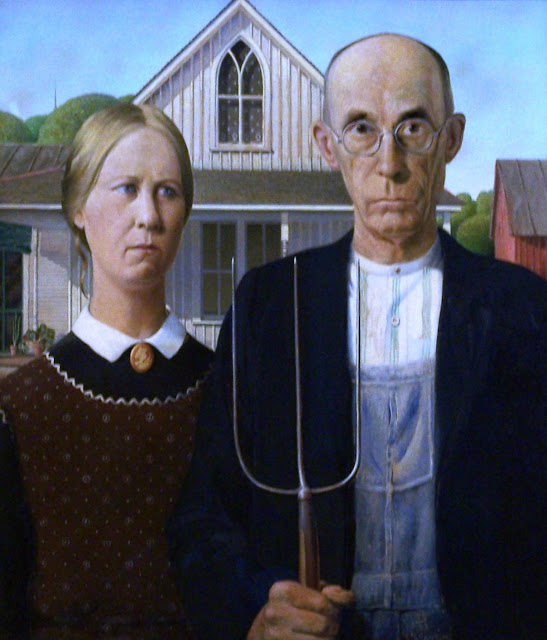It's not just about European painters...
I also love American painters and the Art Institute of Chicago has a superb collection of paintings by some of the most famous American painters.
The Art Institute has one of the most iconic paintings ever...
American Gothic (1930) by Grant Wood
Grant Wood adopted the precise realism of 15th-century northern European artists, but his native Iowa provided the artist with his subject matter. American Gothic depicts a farmer and his spinster daughter posing before their house, whose gabled window and tracery, in the American gothic style, inspired the painting's title. In fact, the models were the painter's sister and their dentist.
Here's another painting known throughout the art world...
Nighthawks (1942) by Edward Hopper
Edward Hopper said that Nighthawks was inspired by "a restaurant on New York's Greenwich Avenue where two streets meet," but the image, with its carefully constructed composition and lack of narrative, has a timeless quality that transcends its particular locale. One of the best-known images of 20th-century art, the painting depicts an all-night diner in which three customers, all lost in their own thoughts, have congregated. Fluorescent lights had just come into use in the early 1940s, and the all-night diner emits an eerie glow, like a beacon on the dark street corner. Hopper eliminated any reference to an entrance, and the viewer, drawn to the light, is shut out from the scene by a seamless wedge of glass. The four anonymous and uncommunicative night owls seem as separate and remote from the viewer as they are from one another.
George Wesley Bellows (1882-1925) actually taught at the Art Institute of Chicago in 1919. Bellows' later works are the triumphs of American realism.
The Palisades (1909) by George Bellows
Love of Winter (1914) by George Bellows
Gifford Beal’s early work was extremely popular in both subject matter and in method: sparkling color and light carried by quick impressionist brushstrokes. Gradually, he moved away from the impressionist style and adopted a broadly realistic style. Muted tones, strong, thick brushstrokes, and simplified compositions characterize his works such as this one:
The Puff of Smoke (1912) by Gifford Beal
During the 1890s the area surrounding his Greenwich, Connecticut home became John Henry Twachtman's main subject matter. Influenced by Impressionism he was often compared with Claude Monet and James McNeill Whistler. The painting below depicts Horseneck Brook on Twachtman's Connecticut property. Like a Monet series, Twachtman painted the bridge six different times; each time its shape is slightly different in each work.
The White Bridge (1895) by John Henry Twachtman
Like George Wesley Bellows, Twachtman loved painting scenes of winter.
Icebound (1889) by John Henry Twachtman
John Singer Sargent was the most successive portrait painter of his era. In the early 1880s Sargent regularly exhibited portraits at the Paris Salon, and these were mostly full-length portrayals of women. Sargent's best portraits reveal the individuality and personality of the sitters; his most ardent admirers think he is matched in this only by Velázquez, who was one of Sargent's great influences.
Mrs. George Swinton (1897) by John Singer Sargent
The Fountain, Villa Torlonia, Frascati, Italy (1907) by John Singer Sargent
I also like the colors and the subjects in the painting below. John Sloan often painted the leisure activities of working class women and the social changes of the 20th century.
Renganeschi's Saturday Night (1912) by John Sloan
This painting by William Glackens is one of my favorites painting in the Art Institute. I love the use of such vivid colors. You can see how Glackens became influenced by Renoir in this painting. It really reminds me of Renoir's famous Bal du Moulin de la Galette. Glackens was known in some circles as the "American Renoir".
Mouquin's (1905) by William Glackens
Of course I can't forget the female American painters. In the early part of the 20th century, Elizabeth Sparhawk-Jones was a well-known, heralded female painter; the New York Times anointed her “the find of the year” in 1908. However, due to her struggles with mental illness, she disappeared from the art scene. Twenty years later she re-emerged with an original style that sparked a second success as a painter. However, I love this early work of hers depicting the female employees assisting customers in the new concept of the "department store".
Shoe Shop (1911) by Elizabeth Sparhawk-Jones
And finally there is the most famous female American Impressionist painter, Mary Cassatt. Mary Cassatt first became acquainted with Edgar Degas and eventually participated in exhibitions with other famous French Impressionists.
On a Balcony (1878) by Mary Cassatt
Many of Cassatt's works emphasized the bond between Mother and Child...
The Child's Bath (1893) by Mary Cassatt
Summertime (1894) by Mary Cassatt
I have shown you just a handful of the works by American painters that hang in the Art Institute of Chicago. Over 1,000 paintings and sculptures from the 18th century to the 1950s are part of the permanent collection. The paintings in this post along with the paintings I showed you in the previous two posts proves the Art Institute of Chicago is a world-class art museum.
- Admission for adults is $18.00**
- Admission for Students and Seniors is $12.00.
- Closed Thanksgiving, Christmas, and New Year’s days.
- Open Monday, Tuesday, Wednesday 10:30-5:00.
- Open Thursday 10:30-8:00.
- Open Friday, Saturday, Sunday 10:30-5:00.
- Free Family Wednesdays: Admission to the Art Institute of Chicago is free to Illinois residents the first and second Wednesday of every month.
** Chicago residents receive a $2 discount on admission in recognition of the significant support given to the museum through local property taxes. A valid photo ID with a resident address is required.
For more information, visit: http://www.artic.edu/.














